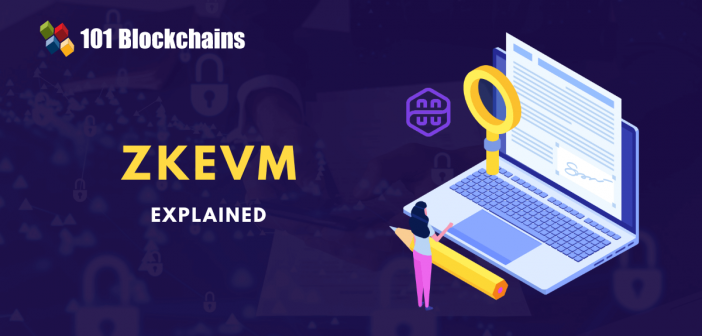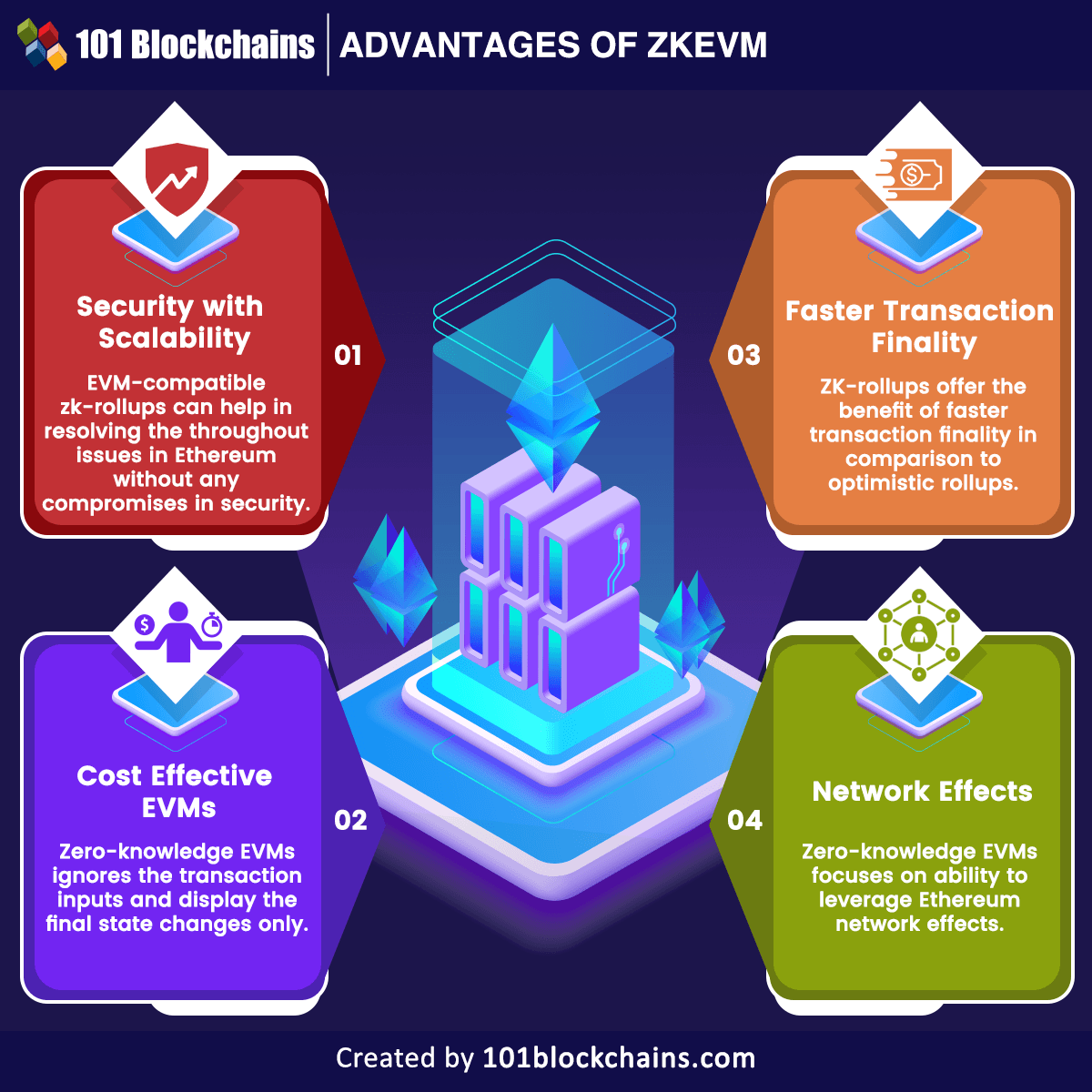Learn how blockchain truly works, master key definitions, and uncover what makes smart contracts so "smart." Dive into the fundamentals, gain valuable insights, and start your blockchain journey today!

- Guides
James Howell
- on April 12, 2023
Know Everything About zkEVM
Blockchain has become a popular term in the domain of technology right now. The massive transformation of conventional technologies with decentralization and new innovative technologies such as metaverse and NFTs rest on blockchain. One of the significant aspects of blockchain is cryptographic security. The fundamentals of zkEVM explained for beginners would shed light on the importance of additional tools for safeguarding blockchain networks.
zkEVM or Zero-Knowledge Ethereum Virtual Machine is a type of EVM that creates zero-knowledge proofs for verifying correctness of each program. The zero-knowledge EVMs have been developed for execution of smart contracts with the support of zero-knowledge proofs. The following post offers a comprehensive introductory guide to zkEVMs with their meaning, significance, working and examples.
What is a Zero-Knowledge Ethereum Virtual Machine?
The first thing you need to learn about zkEVMs is their meaning. Interestingly, you can understand the zkEVM meaning by breaking down the term into its individual components. Zero-knowledge Ethereum Virtual Machines are an important category in zero-knowledge rollups or zk-rollups, which are powerful Ethereum layer 2 scaling solutions.
ZK-rollups work by submitting transaction data to Ethereum mainnet with zero-knowledge proofs that verify the validity of transactions in off-chain batches. Initially, zk-rollups did not have the capability for smart contract execution, thereby focusing specifically on general token payments and exchanges. However, zkEVMs have enabled zk-rollups to offer support for dApp development on Ethereum.
The answer to “What does ZK rollup stand for?” explains a significant portion of the functionality of zero-knowledge EVMs. It is not a regular virtual machine as it offers additional features for proving correctness of program execution. At the same time, the zkEVM could also verify the validity of outputs and inputs in the operations of virtual machines.
Important Components of zkEVMs
You can understand zkEVM Github resources effectively with how Ethereum Virtual Machine can improve with zero-knowledge proofs. As you can notice, the two components of zkEVM are zero-knowledge proofs and Ethereum Virtual Machine. Let us dive deeper into the meaning of zkEVM in the following sections.
-
EVM
Ethereum Virtual Machine is the core element of the massive ecosystem of Ethereum dApps. It is the runtime environment that facilitates execution of smart contracts on Ethereum network. The Ethereum Virtual Machine is an important highlight in zkEVM examples for its identity as the universal machine for dApps.
Ethereum Virtual Machines can execute smart contracts scripted in Solidity and other Ethereum programming languages. Zero-knowledge EVMs support EVM compatibility as they do not require extensive modification in the logic for executing Ethereum smart contracts.
-
Zero-Knowledge Technology
Ethereum Virtual Machine or EVM never had any objectives for offering zero-knowledge support. Therefore, development of EVM-compatible virtual machines with support for zero-knowledge proofs is a challenging task. The advancements in research and innovation have introduced flexibility for wrapping EVM computation process in zero-knowledge proofs. You can find different approaches for combining EVM processes with ZKP computation in different zkEVM projects.
Curious to understand the complete smart contract development lifecycle? Become a member and get free access to the Smart Contracts Development Course Now!
Working of Zero-Knowledge Ethereum Virtual Machine
The next vital highlight in guides on zkEVMs draws attention toward its working. Zero-knowledge EVMs appear as an innovative improvement over conventional Ethereum Virtual Machines. You can use a zkEVM explorer to identify how it resembles general EVMs in terms of transition between states through program operations. On top of it, zkEVM serves as important proof for verifying the correctness of all aspects of the smart contract deployment computation. Here is a review of the working of a common EVM to understand the special additions with a zkEVM.
Working of EVM
Ethereum Virtual Machine is a state-based machine that changes states according to inputs. Smart contract execution processes result in a change in the state of the EVM, also referred to as state transition. Before the outline of working on zkEVM explained in detail, you need to check out the following steps in EVM smart contract execution.
- Contract bytecode obtained from the source code must be loaded from the storage system of EVM, followed by execution across peer-to-peer nodes in the Ethereum Virtual Machine. The nodes utilize similar transact inputs, which ensures consistency in results of every node.
- EVM Opcodes in the bytecode could facilitate interaction with different components in the state of the EVM. Opcodes can address the requirements of read-write operations with the storage system for the EVM.
- EVM Opcodes carry out the computation process on values from state storage, followed by returning new values. The new update helps in transitioning the EVM to a new state, replicated by other nodes.
What is Different about the Working of zkEVM?
The explanation of answers for “What does ZK rollup stand for?” offers only one side of the description of how zkEVM works. One of the prominent aspects of the working of zkEVM is the facility for generating zero-knowledge proofs that could help in verifying different parameters of transactions.
- First of all, zkEVMs feature bytecode access which helps in checking whether the virtual machine has loaded the correct smart contract logic from right address.
- The detailed overview of zkEVM Github repositories also offers insights on the use of read/write operations in working of zkEVMs. Zero-knowledge EVMs check whether the smart contract obtains right values from the storage before processing.
- Subsequently, zkEVMs verify the correctness of output values after the execution process. In the final step, zkEVMs deal with computation verification to ensure correct execution of opcodes.
Learn the basic and advanced concepts of Ethereum and understand how to get started developing with Ethereum by enrolling in the Ethereum Development Fundamentals.
How Can You Build a Zero-Knowledge EVM?
The outline of important highlights in the architecture of zkEVMs can provide you with an answer about their significance. You can use a zkEVM explorer to evaluate how zero-knowledge EVMs present effective improvements for secure dApp development. The process of building a zkEVM utilizes different parts of its architecture, including the execution environment, verifier contract and proving circuit. Here is an explanation for using each component of the zkEVM architecture for creating a secure EVM.
-
Execution Environment
The execution environment serves an important role in supporting the deployment of smart contracts in the zkEVM. Execution environment of zkEVM has considerable similarities to EVM as it needs an initial state and current transaction for generating a new state.
-
Proving Circuit
The proving circuit generates ZKPs in zkEVM examples which are essential for verification of transaction validity in the execution environment. The proof generation process leverages the pre-state and post-state information and transaction inputs for creating ZKPs. Finally, the prover could obtain verifiable proof of the validity of concerned state transition.
-
Verifier Contract
Another crucial highlight in the architecture of zkEVM refers to the verifier contract. It takes on the responsibility of verifying the validity proofs generated by the zk-rollups. The verifier contract also needs the input and output of the zk-rollup for transaction verification. Subsequently, the verifier carries out computation on the proof alongside confirming the correctness in computation of outputs from concerned inputs.
Significant of zkEVM Opcodes
The fundamentals of zkEVM explained another crucial factor in their working, i.e., zkEVM opcodes. The opcodes are practically low-level machine instructions that can help in execution of programs through EVM-compatible zk-rollups. Just like in the case of the EVM, contracts scripted in high-level languages must be converted to bytecode to help the virtual machine with interpretation.
The bytecode provides the opcodes for executing related programs upon deployment in the virtual machine. zkEVM opcodes are important because of the inefficiencies in using conventional EVM opcodes for zero-knowledge proving circuits. You can create zkEVM opcodes by following two distinct methods such as the following.
-
Development of Zero-Knowledge Circuits for Regular EVM Opcodes
The development of zero-knowledge circuits for regular EVM opcodes stands true to the zkEVM meaning by introducing zero-knowledge functionalities. You can develop zero-knowledge circuits through implementation of all the EVM instruction sets in arithmetic circuits. Developers can utilize existing tools as well as import existing Ethereum contracts into zk-rollups without the need for additional modifications.
-
Building New Languages for ZK-Proof Computation
The creation of zkEVM opcodes through new languages for ZK-proof computation can offer another solution for introducing zero-knowledge computation in EVM. The new language should support validity proofs. At the same time, you have to develop custom opcodes.
Developers could write contracts directly in a new language or compile the Solidity source code into custom zkEVM opcodes. However, the simplicity of the approach for developing a new language to create zkEVM opcodes also accompanies trade-offs. For example, developers could not access the existing infrastructure and resources on Ethereum.
Upgrade your knowledge of Ethereum and understand the concepts of Ethereum with the Ethereum Flashcard.
Challenges in Developing Zero-Knowledge Ethereum Virtual Machine
The Ethereum Virtual Machine was never designed to support zero-knowledge-proof computation. Therefore, it includes certain features which do not support proving circuits. Some of the prominent challenges noted in zkEVM examples include special opcodes, proving costs, storage overhead and stack-based architecture.
The special opcodes used in zkEVMs for error management and program execution can introduce complexity in the design of proving circuits for EVM transactions.
Stack-based architecture of EVM is significantly simpler in comparison to a register-based structure. However, it creates difficulty in proving computation tasks. Therefore, some of the popular zkEVM platforms use a register-based model.
Another prominent challenge you can note in the zkEVM Github resources is storage overhead. Storage layout of zkEVMs requires Merkle Patricia Tree and Keccak hashing functions, which impose higher proving overheads. Some of the notable zkEVMs can work on resolving the problem through replacement of the KECCAK256 function. At the same time, replacing the function could result in a disruption of compatibility with existing Ethereum tools and infrastructure.
The final challenge you can notice in zkEVMs points to the proving costs. You cannot take the zero-knowledge proving process out of the equation. The process for creation of zero-knowledge proofs demands specialized hardware along with significant investments in terms of time, effort and money.
Advantages of zkEVM
The discussions on functionalities of a zkEVM explorer and the challenges of building zkEVM also focus on the benefits of zkEVM. Zero-knowledge EVM development is a challenging task. However, innovative improvements in zero-knowledge technology have helped to ensure better prospects for mitigating the challenges. As a result, interest in questions like “What does ZK rollup stand for?” has been growing in the domain of EVM development. Here are some of the most notable advantages of zero-knowledge EVMs, which prove their importance for blockchain and web3 solutions.

-
Security with Scalability
EVM-compatible zk-rollups can help in resolving the throughout issues in Ethereum without any compromises in security. ZK-rollups do not have to share the burden of the protocol rules for Ethereum consensus and could ensure optimization for desired execution speed. Certain estimates have pointed out that ZK-rollups could process around 2000 transactions each second without the burden of higher Ethereum transaction fees.
-
Cost Effective EVMs
The advantage of security with zkEVMs also draws attention to the benefit of cost-efficiency. Rollups rely on the Ethereum mainnet for security, and zk-rollups don’t have to post extensive data on Ethereum mainnet. The validity proofs in the basic zkEVM meaning help in ensuring trustworthy state transitions. Zero-knowledge EVMs could also ignore the transaction inputs and display the final state changes only. As a result, developers and users could save a significant portion of the roll-up costs.
-
Faster Transaction Finality
ZK-rollups offer the benefit of faster transaction finality in comparison to optimistic rollups. In the case of zkEVMs, the transactions posted on Ethereum are finalized immediately with verifiable proof of validity. As a result, the Ethereum mainnet could ensure faster implementation of state updates. Subsequently, the faster transaction finality could ensure better user experiences, especially in the case of DeFi apps and NFTs.
-
Network Effects
The most prominent reason for development of zero-knowledge EVMs focuses on ability to leverage Ethereum network effects. Ethereum offers a large ecosystem, and popular zkEVM examples prove how developers and new projects can derive value. For example, the easier accessibility of audited and tested code libraries, documentation and an extensive set of tools can support easier development of zkEVMs.
Aspiring to Become a Certified NFT Expert? Enroll in Certified NFT Professional (CNFTP) Course Now!
Examples of Zero-Knowledge Ethereum Virtual Machines
The most popular examples of zero-knowledge EVMs have been classified into two sections. The first category of zkEVMs refers to a project which supports native EVM opcodes. On the other hand, the other category of zkEVMs uses customized EVM opcodes. The zkEVM Polygon is an effective example of the working of zero-knowledge EVMs. Polygon Hermez, the zkEVM solution of Polygon, is a zk-rollup featuring a zero-knowledge virtual machine with EVM compatibility.
One of the most significant highlights of Polygon Hermez’s combination of two types of proofs SNARK and STARK. The Polygon zkEVM utilizes a STARK proving circuit for generating validity proofs of state transition. At the same time, STARK proof can also ensure verification for correctness of STARK proofs for ensuring a double layer of verification. Some of the other popular examples of zkEVM include Scroll zkEVM and zkSync zkEVM.
Conclusion
The detailed guide to zkEVM explained the fundamentals of zero-knowledge Ethereum Virtual Machines. Zero-knowledge computation can offer significant improvements for blockchain and web3 development. At the same time, examples such as zkEVM Polygon prove how zero-knowledge EVMs provide the foundation for better user experiences.
With the advantages of faster transaction finality, security and scalability, zkEVMs can grow at a staggering rate in no time. However, it is also important to identify the challenges in developing zkEVMs and how they influence different components in zkEVM architecture. Start learning more about zero-knowledge proofs and discover new approaches for integrating them in EVMs right now.
*Disclaimer: The article should not be taken as, and is not intended to provide any investment advice. Claims made in this article do not constitute investment advice and should not be taken as such. 101 Blockchains shall not be responsible for any loss sustained by any person who relies on this article. Do your own research!






